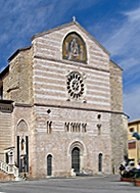
As noted in the main page on the Duomo, the present church was probably begun in the 11th century. The long inscription in two lines across the main façade records its construction following the extension of the nave. It reads:
ANNO MILLENO CENTENO TER MONO DENO HAEC DOMUS ALMA
PATRIS CU[M] SANCTO FLAMINE NATI TEMPESTATE FAMIS
NIMIE CEPIT RENOVARI A DOMINIO FACTO CALIXTO PRESULE MARCO/
EXTITIT VIR MAGNUS LOTHOMUS ACTO COMARCHUS
QUOS CHRISTUS SALVET BENEDICAT ADIUVETAMEN
This translates: "In 1133, the renovation of this noble dwelling of the Father and the one who was conceived by the Holy Spirit [ a reference to Christ and the Trinity] was begun, despite a famine, by Marco, whom Callistus [i.e. Pope Callistus II] had created bishop". It then mentions two other men:
-
✴the “magnus Lothomus”, who must have been a prominent layman, perhaps a feudal magnate; and
-
✴the “comarchus Acto”, literally the mayor.
-
Some authorities believe that Acto (Atto in Italian) was the architect or perhaps the leader of the construction project, while others believe that he was Count Atto, son of Lupo, who is documented in 1138 as a major patron of the Duomo. The inscription proclaims the papal fidelity and orthodoxy of the community:
-
✴It honours Pope Callistus II, whose negotiation of the Concordat of Worms with the Emperor Henry V in 1122 had settled the long dispute between the papacy and the Holy Roman Empire.
-
✴It also honours the Trinity. This is probably a reflection of the controversy surrounding the teaching of the French monk, Peter Abelard, who had been forced to burn his unorthodox tract on the subject in 1121.
-

-
According to Luigi Sensi (referenced below, at p. 83):
-
“The large marble blocks [used for the inscription, two of which are illustrated above], which are probably derived from recovered material, are perfectly squared and smoothed ...” (my translation).
He did not suggest a date for the original working of these blocks, but it might well have dated to Roman times.
The facade has been radically remodelled over the centuries:
-
✴The two side doors and the bifore windows above them are original.
-
✴The upper tympanum was added in the 16th century.
-
✴The facade took was remodelled to a neo-classical design (1790) by Giuseppe Piermarini that survives in the Biblioteca Comunale.
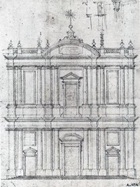
-
✴It was rebuilt in 1904 in order to recapture as far as possible its original appearance, using some original materials. The rose window and central portal date to this period.
Mosaic (1904)
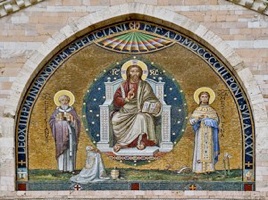
Pope Leo XIII donated the mosaic in the tympanum, which was made in the mosaic workshop of the Vatican. He is depicted kneeling before Christ enthroned, with SS Felician and Messalina standing to the sides.
Baptistery
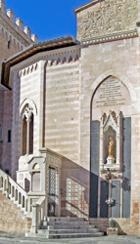
War Memorial (1926)
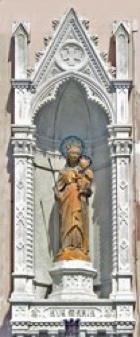
Read more:
L. Sensi, “Le Testimonianze dell’ Antico”, in
G. Benazzi (Ed.), “Foligno A.d. 1201: La Facciata della Cattedrale di San Feliciano”, (1994) Foligno, pp. 81-7
Return to the Main page on the Duomo.
Proceed to the Minor Facade.



